Bees play an important role in longleaf pine ecosystems.
Bees are efficient pollinators known to be key components of healthy forests (Moylett et al. 2020). In longleaf pine ecosystems, pollinators are important for seed production in 80% of plant species, including rare endemics, making them vital to ecosystem function (Cambell et al. 2007; Ulyshen et al. 2020). This biodiverse group of insects is sensitive to habitat changes because of their short life cycles and potential for fast population growth (Maleque et al. 2006; Cole and Hataway 2016). Thus, bees are often used as indicators of community response to restoration and disturbance. Fire, in particular, is a natural disturbance necessary for promoting biodiversity and ecosystem health in longleaf pine savannas (Blanchard and Platt 2021). Although the importance of bees is well-known, they are often not explicitly considered when developing fire-management plans (Figure 1). This publication is aimed to help fire and natural resource managers, landowners, and interested citizens learn more about the benefits of using fire to promote bee diversity in longleaf pine savannas.
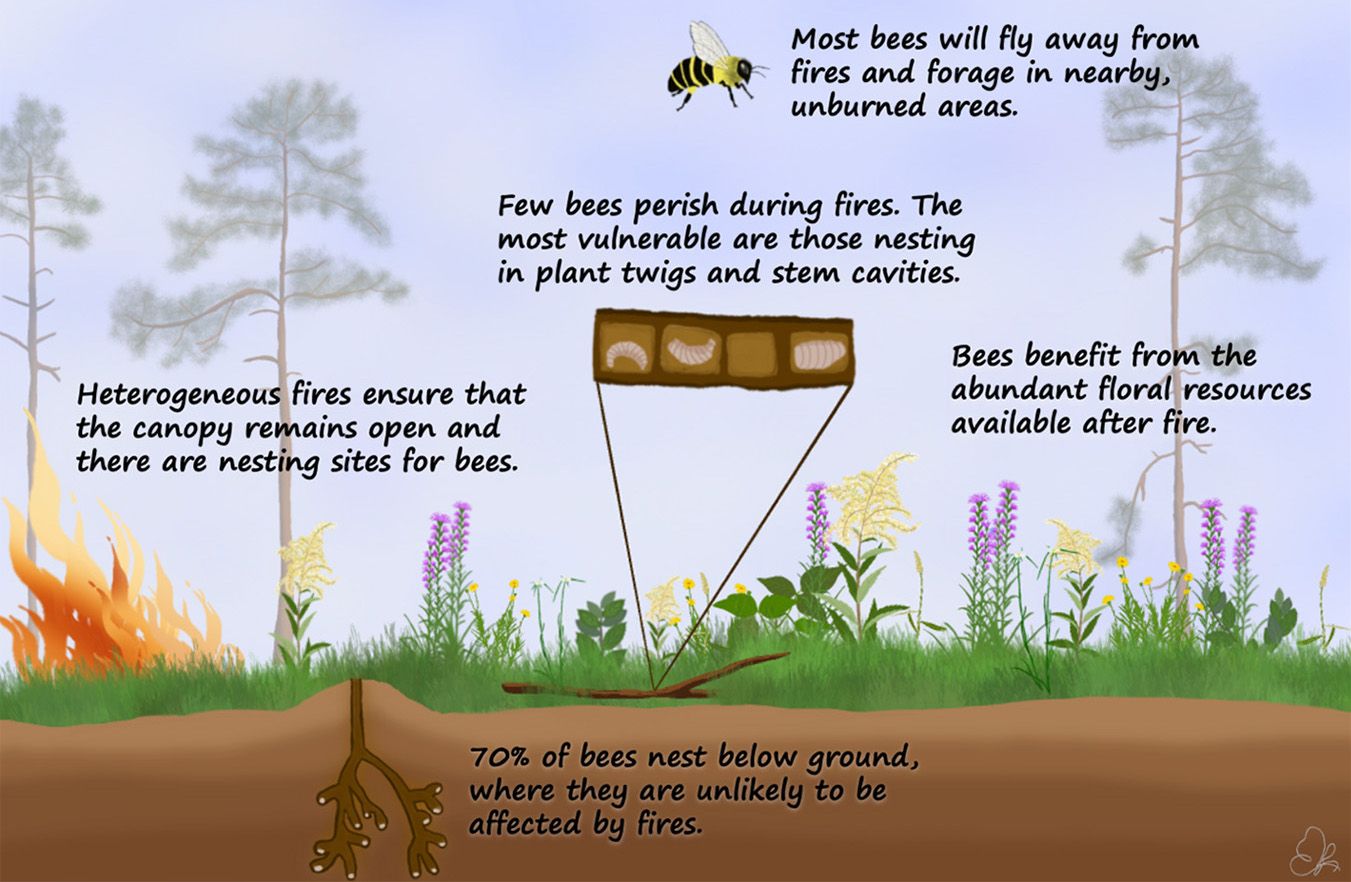
Credit: Raelene M. Crandall
Did you know?
- There are over 4,000 native bee species in the United States.
- 70% of bees nest in soil that is typically loose and somewhat bare.
- Bees need flowers for pollen (their protein source) and nectar (their carbohydrate source).
- Flowers native to wild habitats in the Southeast are often great pollen resources for bees.
Fire has short- and long-term effects on bee diversity.
During fire: Some adult bees and larvae can be killed during a fire, but it is uncommon. Bees in the larval stage nesting belowground and mobile adults are typically able to survive or escape. Soil depths of only 5–10 cm are enough to buffer the heat of low intensity fires (Kreye et al. 2020) and protect ground nesting bees. Additionally, unburned patches within burned areas can provide refuges for other bees that nest in aboveground plant twigs and cavities. Adult bee movement varies by species, but some can move significant distances (up to 2 km) allowing them to forage in unburned areas or patches both during (Figure 2) and immediately after fires (Simmons and Bossart 2020).
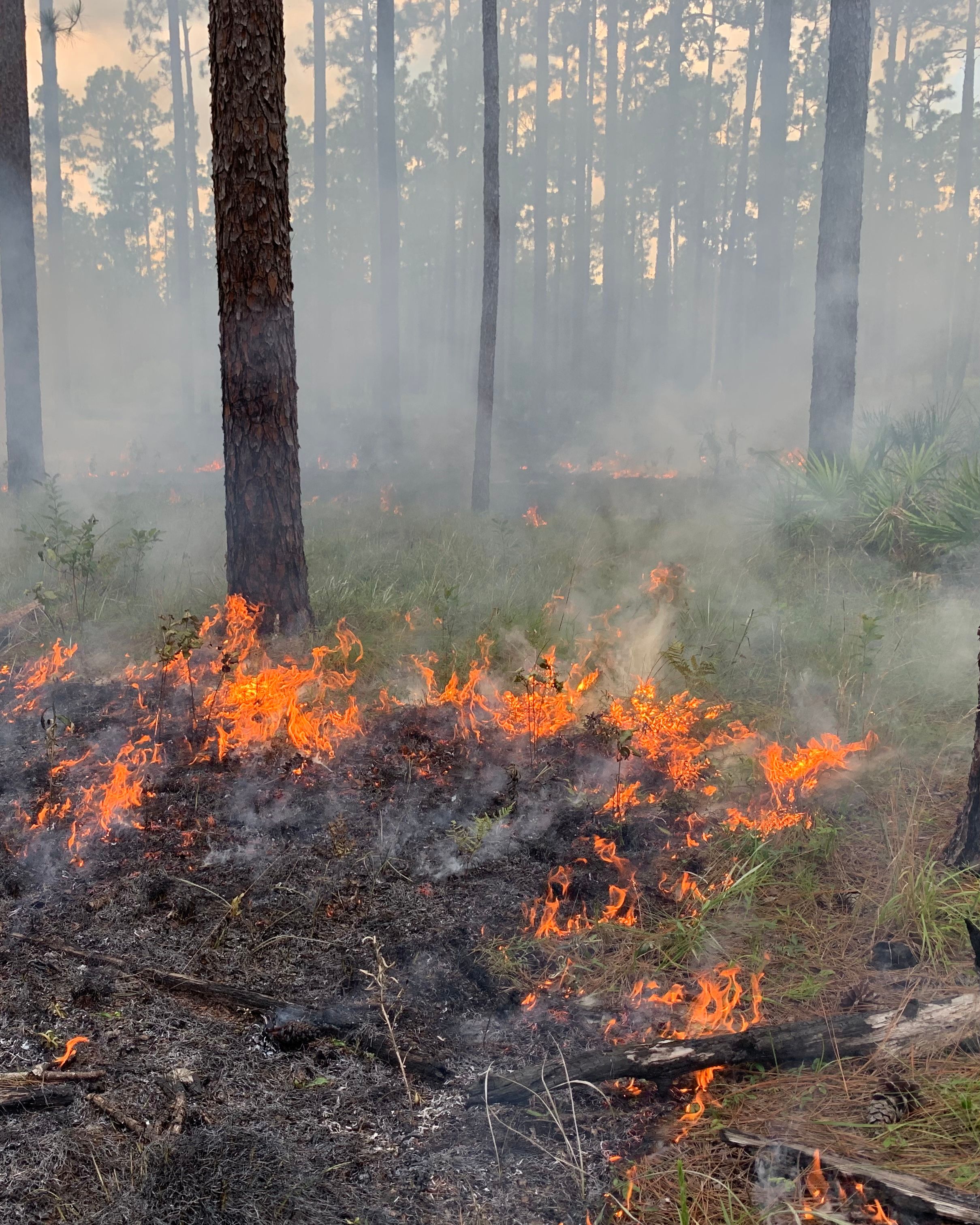
Credit: Raelene M. Crandall
After fire: Habitat structure and resources are significantly different after fires. There are often fewer nesting sites for twig and cavity nesters and fewer floral resources overall, but more sites for ground-nesting bees. These effects are short-lived, however. Within several months, native flower diversity increases, and bees have even been observed foraging and preparing nesting areas shortly after intense fires (Simmons and Bossart 2020). Bees that are active during all seasons and reproduce several times each year can rebound more quickly after fires than bees with different reproductive strategies. In general, fires only result in a short-term reduction in bee abundance and richness, likely because bees temporarily forage in nearby areas with higher floral diversity (Simmons and Bossart 2020).
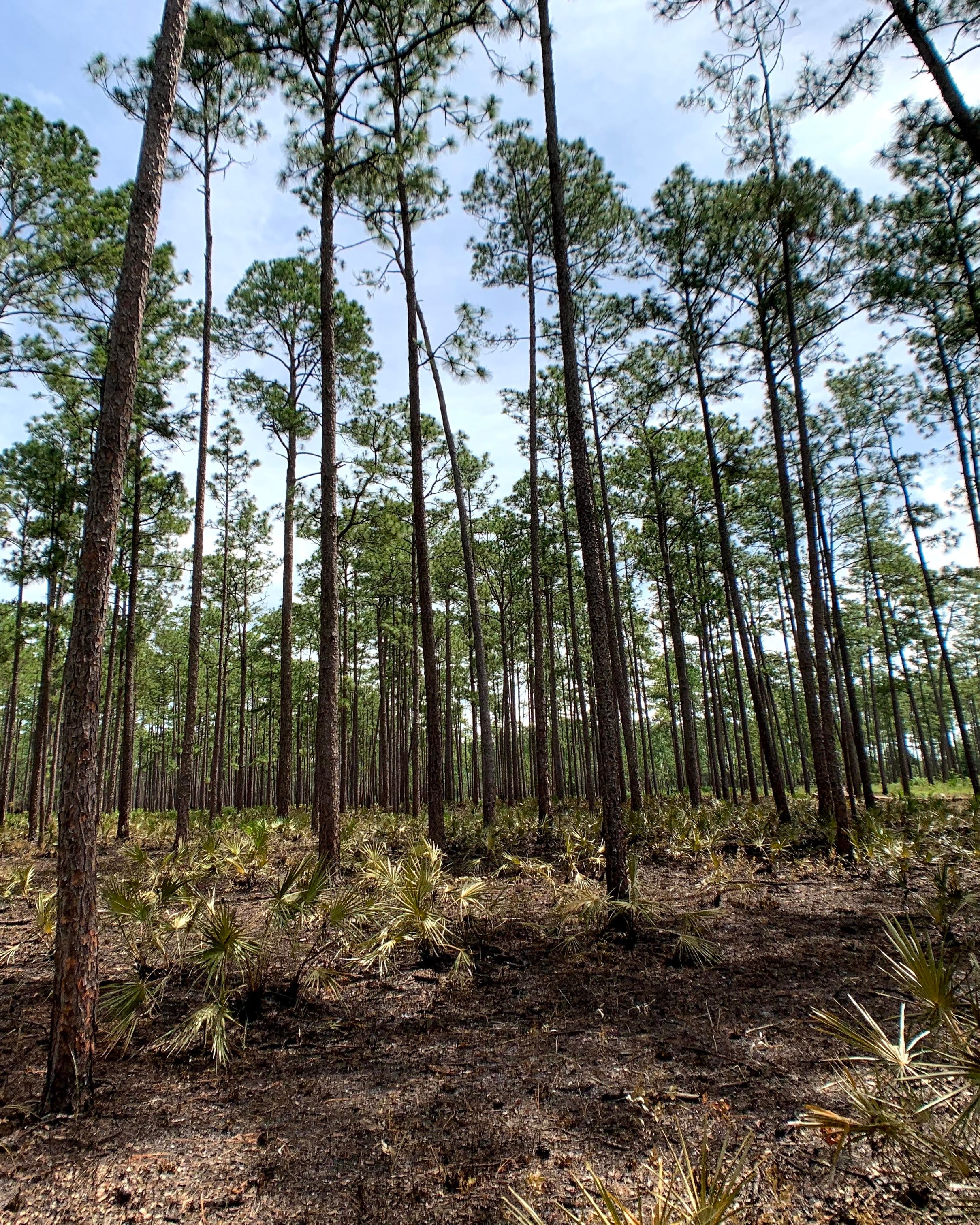
Credit: Raelene M. Crandall
As time since fire increases: Areas that have burned more recently (less than 3 years ago) have higher species richness and abundance of bees than long unburned areas (50 years or more since fire; Moylett et al. 2020). This is most likely because a higher abundance and diversity of flowering plants in recently burned areas provide floral resources for bees (Fig. 4), and the fire-maintained open canopy increases groundcover and nesting sites. Areas that remain unburned may lose bee richness and abundance (Simmons and Bossart 2020) such that after 50 years of fire suppression, there might be a significant decrease in bee abundance and only a third of the diversity found in frequently burned areas (Moylett et al. 2020). Bees persisting in long unburned areas are likely generalist species that can pollinate many different species and forage over large distances including both burned and unburned areas. Alternatively, bees may be able to persist because there are patches of open canopy available within unburned areas (Sexton and Emery 2020).
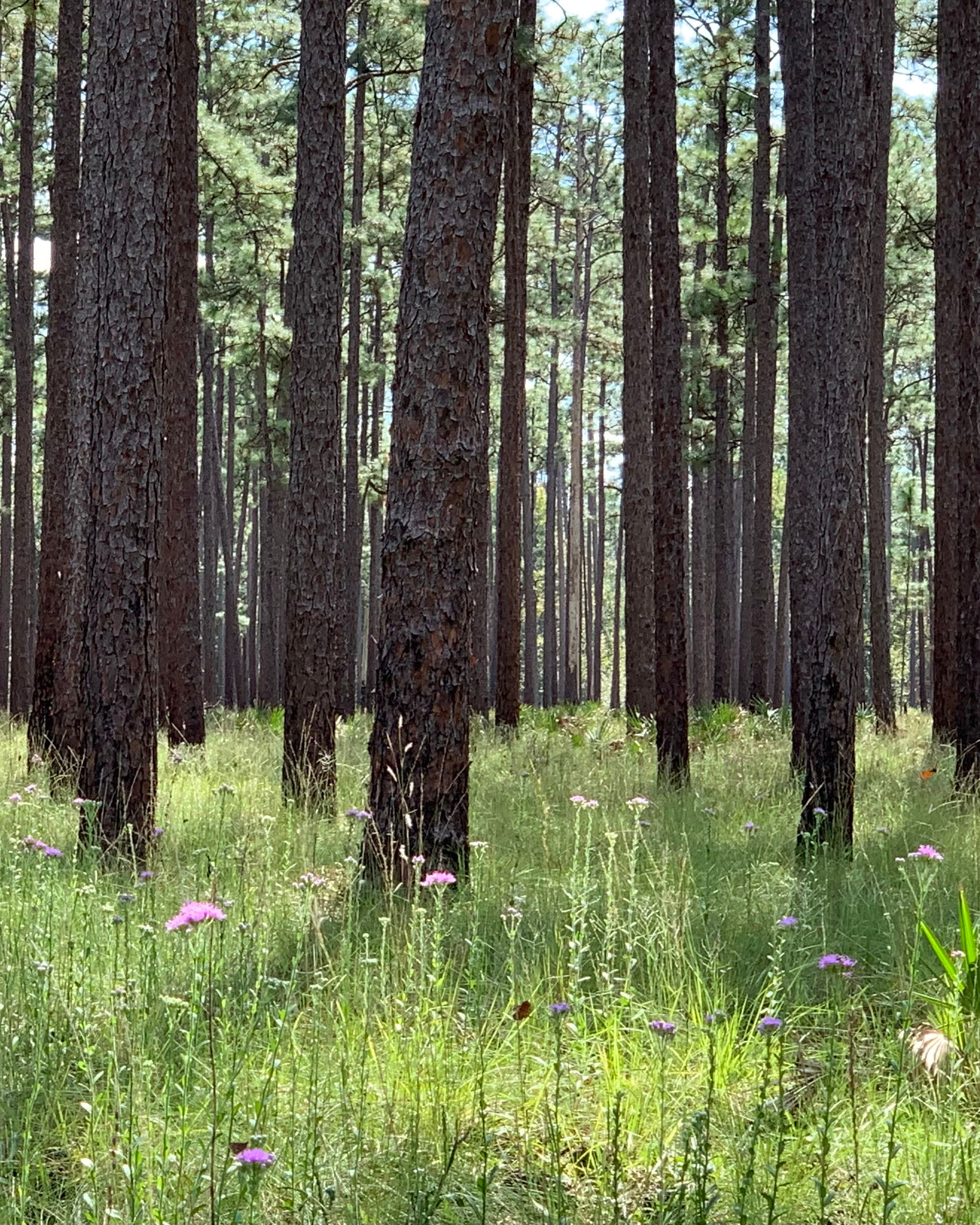
Credit: Raelene M. Crandall
Increasing canopy openness, in general, increases bee diversity.
Frequent prescribed fire decreases overstory tree density (Blanchard and Platt 2021), which in turn supports high bee diversity. Even in the absence of fire, canopy thinning results in increased bee diversity (Odanaka et al. 2020). For instance, Odanaka and colleagues (2020) surveyed bees in remnant and recently logged sites in South Carolina sandhills and found that opening the canopy by thinning trees increased bee abundance by more than 2.4 times and increased bee richness by more than 3 times. These results were consistent across sites regardless of soil type, understory plant composition or previous land use history, but it should be noted that these were mainly generalist bee species.
There are no specific guidelines for the ratio of burned to unburned area or size of canopy gaps necessary to increase bee diversity. Different bee species will have varying responses to patch size and connectivity between patches, depending on how far they forage for resources (Griffin and Haddad 2021). The main goals when developing a fire-management plan should be to: (1) maintain an open canopy by applying frequent prescribed fire (after thinning trees if necessary); and (2) ensure there are refuges for native bees by igniting heterogeneous fires or burning different areas during alternate years.
Conclusion: Frequent, patchy fires benefit bees!
- Native bees are resilient to low-intensity fires in longleaf pine ecosystems.
- Prescribed fires increase floral resources and native ground cover for foraging bees, increasing their diversity and abundance.
- Unburned patches within burned areas and adjacent unburned areas are important refuges for nesting bees during and immediately after fires.
- The practice of applying frequent prescribed fires to longleaf pine savannas in conjunction with maintaining or increasing canopy openness will conserve pollinators and other arthropods.
An Introduction to Common Bee Groups of Pine Savannas
Below are brief descriptions and photos of the most common bee species in the southeastern United States. Open, fire-maintained pine savannas are likely to have species from most of these groups. High diversity of floral pollinators, such as bees, is indicative of a healthy ecosystem (Maleque et al. 2006).
Honey Bees
Apis mellifera
- Non-native species important for providing pollination in agricultural systems
- Construct above-ground, conspicuous colonies
- Can be distinguished from other bees by their distinct honey-yellow and dark-brown stripes on their hind segment
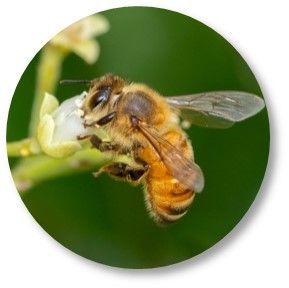
Credit: Laura Langlois Zurro, Bee Conservation Photographer and Founder and Administrator of the Florida Native Bees Facebook Group and iNaturalist Project
Southeastern Blueberry Bee
Habropoda laboriosa
- Active late winter to early spring
- Frequently visit wild and cultivated blueberry plants (Vaccinium spp.)
- Can be identified by the one strip of mustard-yellow hair at the beginning of the hind segment
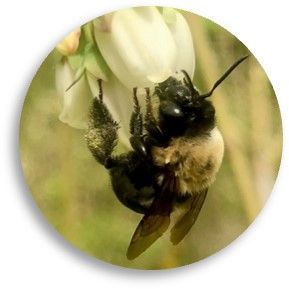
Credit: Sarah Anderson Weaver
Bumble Bees
- Nest in shallow belowground or near-ground cavities and require some undisturbed soil
- Can be distinguished from other bees by their large size and thick, fuzzy hair
- Bumble bee species can be distinguished from one another by their hair patterns (see Strange 2021)
Bombus griseocollis
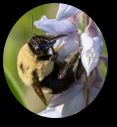
Credit: Laura Langlois Zurro, Bee Conservation Photographer and Founder and Administrator of the Florida Native Bees Facebook Group and iNaturalist Project
Bombus impatiens
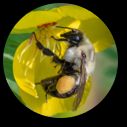
Credit: Laura Langlois Zurro, Bee Conservation Photographer and Founder and Administrator of the Florida Native Bees Facebook Group and iNaturalist Project
Bombus pensylvanicus
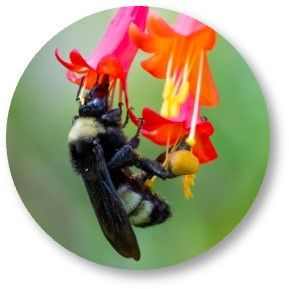
Credit: Laura Langlois Zurro, Bee Conservation Photographer and Founder and Administrator of the Florida Native Bees Facebook Group and iNaturalist Project
Carpenter Bees
- Nest in chewed holes in dead wood
- Can be identified by their large size, lack of hair (as compared to bumble bees), shiny bodies, and iridescent wings
- Males and females look different from one another; males are highly territorial though they are unable to sting
Xylocopa micans
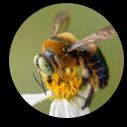
Credit: Laura Langlois Zurro, Bee Conservation Photographer and Founder and Administrator of the Florida Native Bees Facebook Group and iNaturalist Project
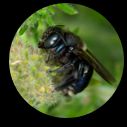
Credit: Laura Langlois Zurro, Bee Conservation Photographer and Founder and Administrator of the Florida Native Bees Facebook Group and iNaturalist Project
Xylocopa virginica
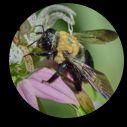
Credit: Laura Langlois Zurro, Bee Conservation Photographer and Founder and Administrator of the Florida Native Bees Facebook Group and iNaturalist Project
Sweat Bees
- Require relatively bare and loose soil to construct their nests in the ground
- Can vary in size but are smaller than bumble bees, carpenter bees, and honeybees
- Are often metallic green, teal, or navy blue
Agapostemon splendens
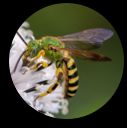
Credit: Laura Langlois Zurro, Bee Conservation Photographer and Founder and Administrator of the Florida Native Bees Facebook Group and iNaturalist Project
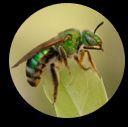
Credit: Laura Langlois Zurro, Bee Conservation Photographer and Founder and Administrator of the Florida Native Bees Facebook Group and iNaturalist Project
Halictus poeyii
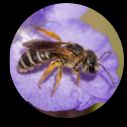
Credit: Laura Langlois Zurro, Bee Conservation Photographer and Founder and Administrator of the Florida Native Bees Facebook Group and iNaturalist Project
Leaf-cutter Bees
- Nest in small holes lined with leaves and other plant materials
- Can be identified by the fuzzy, pollen-collecting hairs on the underside of the hind segment rather than on the legs
- The most common leaf-cutter bee species mimics the appearance of a common carpenter bee species
Mechachile xylocopoides
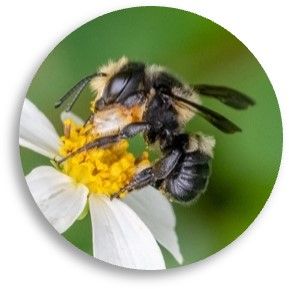
Credit: Laura Langlois Zurro, Bee Conservation Photographer and Founder and Administrator of the Florida Native Bees Facebook Group and iNaturalist Project
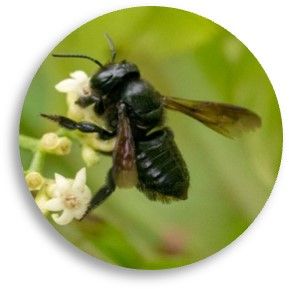
Credit: Laura Langlois Zurro, Bee Conservation Photographer and Founder and Administrator of the Florida Native Bees Facebook Group and iNaturalist Project
Megachile albitartsis
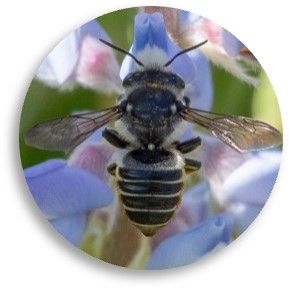
Credit: Laura Langlois Zurro, Bee Conservation Photographer and Founder and Administrator of the Florida Native Bees Facebook Group and iNaturalist Project
Acknowledgement
The authors acknowledge funding for the fire science delivery program “The Southern Fire Exchange: Putting Fire Science on the Ground” from the Joint Fire Science Program and in agreement with the United States Forest Service, Southern Research Station. The Southern Fire Exchange supports the dissemination of and access to fire science information. To learn more, visit https://southernfireexchange.org/.
References
Blanchard, M. D., and W. J. Platt. 2021. “Ground Layer Microhabitats Influence Recruitment of Longleaf Pine in an Old-Growth Pine Savanna.” The American Midland Naturalist 185 (1): 15–31. https://doi.org/10.1674/0003-0031-185.1.15
Campbell, J., J. Hanula, and T. Waldrop. 2007. “Effects of Prescribed Fire and Fire Surrogates on Floral Visiting Insects of the Blue Ridge Province in North Carolina.” Biological Conservation 134 (3): 393–404. https://doi.org/10.1016/j.biocon.2006.08.029
Cole, T. J., and R. A. Hataway. 2016. “Prescribed Burning Affects a Measure of Fitness in Ctenus hibernalis (Araneae: Ctenidae) at Oak Mountain State Park, Shelby County, AL.” Southeastern Naturalist 15 (4): 646–652. https://doi.org/10.1656/058.015.0407
Griffin, S. R., and N. Haddad. 2021. “Connectivity and Edge Effects Increase Bee Colonization in an Experimentally Fragmented Landscape.” Ecogeography 44 (6): 919–927. https://doi.org/10.1111/ecog.05299
Kreye, J. K., J. M. Varner, and L. N. Kobziar. 2020. “Long-Duration Soil Heating Resulting from Forest Floor Duff Smoldering in Longleaf Pine Ecosystems.” Forest Science 66 (3): 291–303. https://doi.org/10.1093/forsci/fxz089
Maleque, M., H. Ishii, and K. Maeto. 2006. “The Use of Arthropods as indicators of ecosystem integrity in forest management. Journal of Forestry, 104, 113–117.
Moylett, H., Youngsteadt, E., and C. Sorenson. 2020. “The Impact of Prescribed Burning on Native Bee Communities (Hymenoptera: Apoidea: Anthophila) in Longleaf Pine Savannas in the North Carolina Sandhills.” Environmental Entomology 49 (1): 211–219. https://doi.org/10.1093/ee/nvz156
Odanaka, K., J. Gibbs, N. E. Turley, R. Isaacs, and L. A. Brudvig. 2020. “Canopy Thinning, Not Agricultural History, Determines Early Responses of Wild Bees to Longleaf Pine Savanna Restoration.” Restoration Ecology 28 (1): 138–146. https://doi.org/10.1111/rec.13043
Sexton, A. N., and S. M. Emery. 2020. Grassland Restorations Improve Pollinator Communities: A Meta-Analysis.” Journal of Insect Conservation 24:719–726. https://doi.org/10.1007/s10841-020-00247-x
Simmons, S. A., and J. L. Bossart. 2020. “Apparent Resilience to Fire of Native Bee (Hymenoptera: Apoidea) Communities from Upland Longleaf Pine Forests in Louisiana and Mississippi.” Southeastern Naturalist 19 (3): 567–581. https://doi.org/10.1656/058.019.0316
Strange, L. A. 2021. “The Bumble Bees of Florida, Bombus spp.” 2012. EENY-050. EDIS 2012 (1) https://doi.org/10.32473/edis-in207-2011
Ulyshen, M. D., S. Pokswinski, and J. K. Hiers. 2020. “A Comparison of Bee Communities between Primary and Mature Secondary Forests in the Longleaf Pine Ecosystem.” Scientific Reports 10 (1): 2916. https://doi.org/10.1038/s41598-020-59878-4